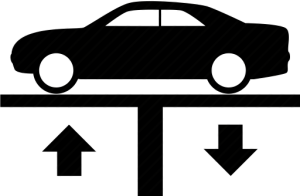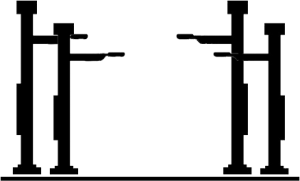Setting up a workshop – what lift to choose?
 Setting up a workshop – what lift to choose?
Setting up a workshop – what lift to choose?
What lift to choose? Choosing a hoist is one of the most common issues among people who are just starting their adventure with mechanics in a company. A considerable difference here can be created by the issue of experience and education in the field of mechanics, although this is only one of several factors that should be taken into account. It is always worth getting acquainted with the full offer of the manufacturer to compare many factors, such as:
- orientation in the operating costs of the device,
- getting expert knowledge about the solutions used in the construction of the lift,
- determining the installation conditions of the lifting device that the manufacturer has provided. Very important, especially at the building design stage. With the need to adapt the existing substrate, it will guarantee its proper preparation,
- determination of service needs at a given position and their confrontation with the usefulness of the lift,
- determining whether a given lift unit promises to expand the scope of services in the future or whether it will require modernization or replacement,
- clarifying the scope of warranty and post-warranty service.
A very helpful issue in the selection of such a machine is very often direct contact with the producer or wholesaler, such questions are usually personalized and will best allow you to verify whether a given lift is created for us.
Among the lifts we distinguish the following types:
 Point lifts
Point lifts
The point lift will certainly be the smallest and the minimum device in the workshop. Its small size makes it suitable for virtually any workshop. This variant will work great in tire services, where lifting of the entire vehicle is not required. The kind of point lift used is the discretionary issue. The user will decide whether it should be a pneumatic, pneumatic-hydraulic or hydraulic unit. As for the construction itself, the user’s preferences will also be the main ones here. For example, others in the case of cars with reduced suspension and others in the service of delivery vehicles. In addition to low purchase costs, these types of lifts do not generate high operating costs. If their service, review is necessary, expenses will certainly not be high. If there is a need to replace them due to a significant degree of wear, the purchase of subsequent ones will not be a significant burden. It is also certain that in the course of use in the workshop, they will allow you to generate profits, with a lower commitment of equipment resources.
Single column lifts
Which lift should I choose? Single column lifts are the most frequently chosen workshop equipment for lifting cars in the workshop and may be one of the best to choose from. Particularly useful may be, among others, in bodyshops and typical tire services. These are usually dedicated constructions that allow you to lift one of the sides of the vehicle. Single-column lifts that allow lifting the entire vehicle, will be used wherever it is essential to maintain the passability of the position, beyond the time of his work. Such a solution may also result from ground restrictions, which do not allow permanent fixing of the selected elevator unit. These elevators simultaneously guarantee high work efficiency compared to the cost of purchase and operation.
Two-column lifts
Hoists based on two columns is the first lift, which is permanently mounted in the ground. They are considered safe and ergonomic for their abilities. Currently, we will be able to purchase a lift adapted to all car versions, including for vehicles with low chassis, SUVs, 4×4, etc. In addition, these units are equipped with many useful accessories. This will include instrumentation specialized in the area of support points, column synchronization, as well as extensions and elevations of the entire structure. They enable lifting the whole vehicle to the set height. Their columns are fixed to the ground permanently. The stand equipped with a two-column lift guarantees high throughput and high flexibility of work. Due to unrestricted access to the vehicle chassis, the operator has the possibility to carry out a series of maintenance activities.
Four-column lifts
Four-column lifts are the largest and non-mobile lifts on the list. At the same time, they will prove to be the best alternative for the channels in the workshop. They are perfect for any workshop work on the car. Recommended rather in specialized workshops, but with appropriate configuration will also allow for complementary tire service. They will be used in rooms with appropriate dimensions. The length of the platforms depends on the vehicle category planned for servicing. If the position is to have a developmental character, the correct action will be to choose a unit with a length of 5 meters and more. This will ensure the entry of vans, which are already characterized by significant axle spacing. The user must also foresee that higher vehicles can be served on the station.
If the object is high enough, it does not have to give up full functionality, ie a full range of lifting. With lower objects, it is obvious that the operation of the jack will be compromised in this respect. Although the presence of 4 columns on the bench limits the freedom of movement, it should not negatively affect the ergonomics of its execution and location. The mere fact of lifting vehicles through a 4-column mechanism, however, ensures great safety and comfort of users. The unit is properly leveled and serviced for security, it will certainly allow for trouble-free use. The equipment of such a device is also extremely wide, we can find, for example, recesses for turntables, expansion plates, a subliminal lift and much more.
 Scissor lifts – subliminal
Scissor lifts – subliminal
Sublimators are one of two types of scissor lifts. In variants up to 1 m, commonly referred to as “low lift”, you can plan the service on the tire service. To some extent, the subliminal lift will also allow for standard mechanical work with the car. Variants 2 m, commonly referred to as “high lifting”, will allow for much more. It is only necessary to take into account the limited access within the vehicle’s thresholds. The biggest advantage of this type of hoist is the possibility of mounting in a recess in the floor, which will allow it to be completely hidden. If the lift is not used, other service activities can be practically carried out on the entire stand. It is worth noting that these types of units allow for the free placement of the controller. The user can place it on the selected side, and if necessary, even extend the wires of the electromechanical system. The choice of such a unit certainly corresponds to which jack to choose.
Scissor lifts – overrun
The scissor lift platforms should be regarded as the most specialized units on the list of described lifts. When buying, it is worth considering the price and size of such a lift. These certainly require the user to carefully plan the position. At present, you can find almost only scissor lifts based on a scissor mechanism. They damped the tilting mechanisms used in the last century. For leveling and safety, ratchet mechanisms are generally the same and the jack itself works on the principle of hydraulic actuators. Nowadays, the position of pawls on one of the pair of shears is very popular among the manufacturers of such lifts. The installation does not differ from the requirements for four-column or scissor-scissor units. At this point, it should be mentioned that the scissor version of the inrun after assembly in the recess may meet the criteria set out so-called. measuring benches. Turning to functionality, this type of jacks can be equipped with practically the same equipment used in four-column versions.
Again, the question arises – which jack to choose? – First of all, economical, meeting all the necessary requirements, guaranteeing safety and generating profits.
— Michael N. Adam








